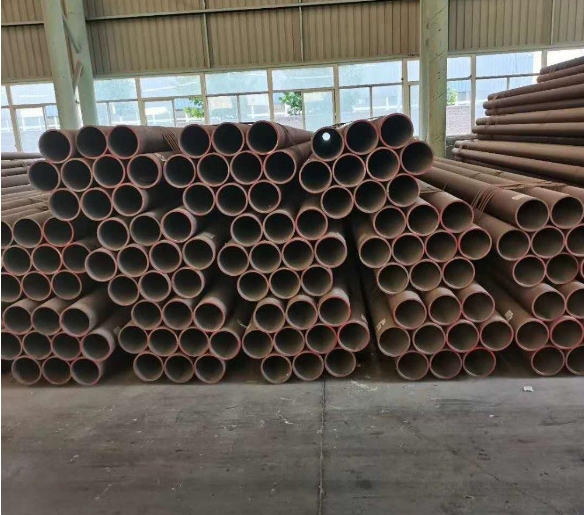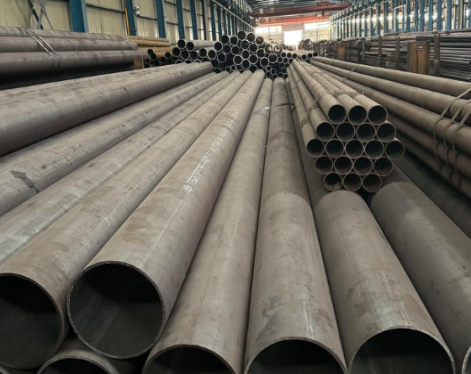What is x-ray inspection
X-ray inspection refers to the use of X-rays to penetrate metal materials, and due to the different absorption and scattering effects of the material on the rays, the film sensitivity is different, resulting in the formation of different blackness images on the negative film. Based on this, it is a testing method to determine the internal defects of the material.
Principle of X-ray flaw detection of carbon steel seamless pipes(cs seamless pipes)
X-ray flaw detection is a non-destructive testing method that uses X-rays to penetrate materials and have attenuation characteristics in materials to find defects. The wavelength of X-rays is very short, generally 0.001~0.1nm. X-rays propagate in straight lines at the speed of light and are not affected by electric and magnetic fields. They can penetrate carbon steel seamless pipes and are attenuated during the penetration process, making the film photosensitive. When X-rays penetrate the pipeline, a series of extremely complex physical processes will occur due to the interaction between the rays and the material. As a result, the rays will be absorbed and scattered, losing part of their energy, and their intensity will weaken accordingly. This phenomenon is called rays. of attenuation. The essence of X-ray flaw detection is based on the different attenuation degrees of ray energy between the inspected seamless pipe and its internal defect medium, which causes the difference in intensity of rays after penetrating the workpiece, so that the latent image generated by the defect projection is obtained on the photosensitive material (film). After darkroom processing, the defect image is obtained, and then the nature of the internal defects of the pipeline and the film grade are uated against the standards.

Advantages and Disadvantages of X-ray Flaw Detection of Carbon Steel Seamless Pipes
advantage:
1. The flaw detection results (film photos) are visualized and conducive to analysis.
2. The flaw detection results can be stored for a long time
3. Flaw detection technology and inspection work quality can be inspected
shortcoming:
1. Testing is expensive
2. There are specific restrictions on crack defects
3. Safety precautions need to be considered
X-ray flaw detection precautions
1. The circuits of flaw detection instruments and ancillary electrical equipment must be insulated, and the shells must be reliably grounded. During maintenance, the power supply should be cut off first.
2. Radiographic inspection operators should check their bodies regularly. Protective equipment must be worn when working.
3. Fences and warning signs should be installed at radiographic inspection work sites.
4. When performing radiographic flaw detection, you should evacuate quickly. During the search, mechanical operation should be used, and it is strictly forbidden to touch the radiation source with hands.
5. For X-ray flaw detection, there should be lead protective screens or other protective measures. Before exposure, the operator should turn away from the "window" of the X-ray machine, and the exposure should be carried out after the operator reaches the safe area.
There are four common non-destructive testing methods for carbon steel seamless pipes: radiographic testing (RT), ultrasonic testing (UT), magnetic particle testing (MT) and liquid penetrant testing (PT).Other non-destructive testing methods: eddy current testing (ET), acoustic emission testing (AT), thermal imaging/infrared testing (TIR), leak test (LT), AC field measurement technology (ACFMT), magnetic flux leakage testing (MFL), remote Field detection detection method (RFT), etc.
X-ray inspection refers to the use of X-rays to penetrate metal materials, and due to the different absorption and scattering effects of the material on the rays, the film sensitivity is different, resulting in the formation of different blackness images on the negative film. Based on this, it is a testing method to determine the internal defects of the material.
Principle of X-ray flaw detection of carbon steel seamless pipes(cs seamless pipes)
X-ray flaw detection is a non-destructive testing method that uses X-rays to penetrate materials and have attenuation characteristics in materials to find defects. The wavelength of X-rays is very short, generally 0.001~0.1nm. X-rays propagate in straight lines at the speed of light and are not affected by electric and magnetic fields. They can penetrate carbon steel seamless pipes and are attenuated during the penetration process, making the film photosensitive. When X-rays penetrate the pipeline, a series of extremely complex physical processes will occur due to the interaction between the rays and the material. As a result, the rays will be absorbed and scattered, losing part of their energy, and their intensity will weaken accordingly. This phenomenon is called rays. of attenuation. The essence of X-ray flaw detection is based on the different attenuation degrees of ray energy between the inspected seamless pipe and its internal defect medium, which causes the difference in intensity of rays after penetrating the workpiece, so that the latent image generated by the defect projection is obtained on the photosensitive material (film). After darkroom processing, the defect image is obtained, and then the nature of the internal defects of the pipeline and the film grade are uated against the standards.

Advantages and Disadvantages of X-ray Flaw Detection of Carbon Steel Seamless Pipes
advantage:
1. The flaw detection results (film photos) are visualized and conducive to analysis.
2. The flaw detection results can be stored for a long time
3. Flaw detection technology and inspection work quality can be inspected
shortcoming:
1. Testing is expensive
2. There are specific restrictions on crack defects
3. Safety precautions need to be considered
X-ray flaw detection precautions
1. The circuits of flaw detection instruments and ancillary electrical equipment must be insulated, and the shells must be reliably grounded. During maintenance, the power supply should be cut off first.
2. Radiographic inspection operators should check their bodies regularly. Protective equipment must be worn when working.
3. Fences and warning signs should be installed at radiographic inspection work sites.
4. When performing radiographic flaw detection, you should evacuate quickly. During the search, mechanical operation should be used, and it is strictly forbidden to touch the radiation source with hands.
5. For X-ray flaw detection, there should be lead protective screens or other protective measures. Before exposure, the operator should turn away from the "window" of the X-ray machine, and the exposure should be carried out after the operator reaches the safe area.
There are four common non-destructive testing methods for carbon steel seamless pipes: radiographic testing (RT), ultrasonic testing (UT), magnetic particle testing (MT) and liquid penetrant testing (PT).Other non-destructive testing methods: eddy current testing (ET), acoustic emission testing (AT), thermal imaging/infrared testing (TIR), leak test (LT), AC field measurement technology (ACFMT), magnetic flux leakage testing (MFL), remote Field detection detection method (RFT), etc.









